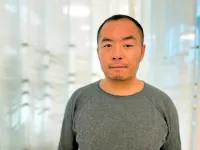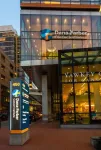(Press-News.org) Statement Highlights:
There are a variety of interrelated social and structural factors that contribute to differences in cardiovascular health among Asian Americans, and these factors are likely different within individual Asian ethnic subgroups.
Asian Americans and Asian immigrants are quite diverse and comprise many ethnic groups.
Social determinants, such as immigration-related factors, discrimination, socioeconomic status, English proficiency and cultural beliefs, may influence health behaviors, access to health care and the ability to follow medical recommendations among Asian Americans.
More research is needed to better understand the specific cardiovascular health needs in individual Asian ethnic groups, identify the underlying reasons why Asian Americans experience differences in quality of cardiovascular care compared with other racial and ethnic populations and reduce disparities in these communities.
Embargoed until 4:00 a.m. CT/5:00 a.m. ET Monday, Sept. 16, 2024
DALLAS, Sept. 16, 2024 — Numerous social and structural factors, including immigration status, socioeconomic position and access to health care, contribute to differences in cardiovascular health and heart disease risk for Asian Americans, and these factors affect Asian ethnic subgroups in different ways, according to a new scientific statement published today in the American Heart Association’s journal, Circulation.
This AHA scientific statement, “Social Determinants of Cardiovascular Health in Asian Americans,” highlights the evidence for the role of social determinants of health in cardiovascular health among Asian American adults and identifies future directions for research to advance health equity for the Asian American population and reduce health disparities in these communities.
Asian Americans are the fastest growing racial group in the United States, with a population projected to reach up to approximately 46 million by 2060. According to the U.S. Census Bureau, Asian Americans will represent more than 10% of the total U.S. population at that time.
However, Asian Americans remain persistently underrepresented as participants in medical research. Previous studies have found that Asian Americans are less willing to participate in health research compared to other racial/ethnic groups. Research conducted exclusively in English may also result in underrepresentation of Asian American individuals with lower English proficiency from different Asian ethnic subgroups.
“Due to the small numbers of Asian Americans recruited in research studies, even when Asian American participants are included, they are frequently combined into a single ‘Asian’ category or grouped with Native Hawaiian and Pacific Islander communities, which results in the masking of clinically relevant differences in health among subgroups of people of Asian descent,” said Chair of the statement writing group Nilay S. Shah, M.D., M.P.H., FAHA, an assistant professor of cardiology and preventive medicine at Northwestern University’s Feinberg School of Medicine in Chicago.
As of 2021, the six largest Asian origin ethnic groups in the U.S. were Chinese, Indian, Filipino, Vietnamese, Korean and Japanese Americans. People of other Asian ethnic groups, such as Pakistani, Thai or Cambodian descent, are less often identified in research studies, limiting understanding of health status in these populations.
Shah said, “Asian American ethnic groups should be individually identified, since each sub-group represents a unique population with distinct social, cultural and health characteristics. There are several social factors that uniquely influence health behaviors and disease risk in individual Asian ethnic groups, including reasons for immigration, socioeconomic position and differences in health care access and utilization.”
Immigration Status and Structural Racism
Immigration policy, citizenship status and legal documentation are widely recognized as important social determinants of health for people immigrating to the U.S. including people from Asia.
Historically, Asian American immigrants have faced structural racism and anti-Asian prejudice resulting in policies restricting immigration into the U.S. The 1882 Chinese Exclusion Act restricted immigration and citizenship based solely on national origin, and Executive Order 9066 led to the unjust, forced incarceration of Japanese Americans during World War II in 1942.
Differences in histories and reasons for migration and resettlement may contribute to suboptimal heart health. For example, Bhutanese, Burmese, Cambodians, Hmong, Laotians and Vietnamese people have frequently arrived in the U.S. as refugees. Refugees are more likely to experience chronic stress due to being exposed to war, violence, hunger and trauma, which may worsen heart health. Real and perceived discrimination may also influence cardiovascular health by leading to increased stress, poor sleep habits, and other suboptimal health behaviors.
Asian Americans without documented immigration status often lack employer-based health insurance. Non-U.S. citizens also have limited access to federal and state health insurance programs, which may contribute to disparities in health outcomes. In addition, lack of health insurance and concerns about immigration status can limit access to timely health care and may also deter individuals from seeking preventive care for cardiovascular risk factors.
Socioeconomic and Social Factors
Due to the socioeconomic diversity of Asian communities, there are substantial differences in the physical and social characteristics of neighborhoods in which Asian Americans live. The complex interplay of social determinants of health, including social support, neighborhood walkability and access to nutritious foods, influence cardiovascular health and contribute to differences across ethnic groups.
While the Asian American population overall is relatively a high-income group, there are significant differences within individual ethnic groups. In 2019, median annual household income ranged from approximately $44,000 per year in Burmese Americans to $119,000 per year among Indian Americans (compared to the average of $85,800 for all Asian Americans).
Employment status in the U.S. is frequently related to health insurance coverage, residence in resource-rich neighborhoods and housing stability. A nationally representative survey of Asian Americans from 10 ethnic backgrounds found that adults who were employed were more likely to report having better health.
In addition, Asian Americans with less than a high school education were 73% less likely to have ideal heart health compared to those with college degrees. A potential explanation is that people employed in low-wage occupations, such as in the service and food industries, may experience greater discrimination and have fewer benefits and employee protections.
Previous research has found that food insecurity, defined as limited or uncertain access to adequate amounts of food, and nutrition security, which refers to the availability, accessibility and affordability of healthy foods, are associated with increased overweight and obesity, type 2 diabetes and cardiovascular mortality in all communities. In the wake of the COVID-19 pandemic, estimates for food insecurity increased by approximately 25% for Vietnamese American adults and 53% for Filipino American adults.
Acculturation, or the process of adapting to a different culture, also affects heart disease risk factors in people who immigrate to the U.S. For example, greater availability and consumption of processed and fast foods and more sedentary lifestyles are known risk factors associated with higher rates of obesity.
Differences in Health Access and Literacy
Asian Americans, especially those not born in the U.S., often experience difficulty in accessing health care services, inadequate health communication between clinicians and patients, cultural differences in health-related beliefs and discrimination in the health care system.
Prior research suggests that gaps in health insurance coverage within some Asian American subgroups, such as Korean and Vietnamese Americans, may be attributable to high rates of employment in occupations that less often provide health insurance coverage, such as jobs in the construction, maintenance or transportation industries, working for a small business or being a small business owner.
English proficiency varies considerably among Asian ethnic groups in the U.S. Limited English proficiency may impact cardiovascular health by preventing patients from adequately reporting symptoms or health concerns. In addition, insufficient use of interpretation/translation services may prevent health care professionals from adequately understanding and addressing health concerns in Asian Americans with limited English proficiency.
Health literacy, or knowledge about health services, also varies across Asian American ethnic groups. Limited health literacy can negatively affect the use of preventive care and/or following medical instructions and taking medications as prescribed. Asian immigrants may also gravitate towards traditional, complementary or alternative medicine practices common in Asian countries, such as acupuncture or herbal therapies.
Shah said, “All of these social determinants of health are likely interrelated, and the cumulative impact of these structural and social risk factors contributes to suboptimal cardiovascular health in Asian Americans. There is an urgent need to understand these challenges and address them with effective prevention strategies to help improve their long-term cardiovascular health. Achieving health equity in this rapidly growing population will require multi-level interventions that target the key factors influencing cardiovascular health and account for the unique experiences within individual Asian subgroups.”
The scientific statement was prepared by the volunteer writing group on behalf of the American Heart Association’s Prevention Science Committee of the Council on Epidemiology and Prevention and the Council on Cardiovascular and Stroke Nursing; the Council on Hypertension; the Council on Lifestyle and Cardiometabolic Health; the Council on Basic Cardiovascular Sciences; the Council on Clinical Cardiology; the Council on Peripheral Vascular Disease; and the Council on Quality of Care and Outcomes Research. American Heart Association scientific statements promote greater awareness about cardiovascular diseases and stroke issues and help facilitate informed health care decisions. Scientific statements outline what is currently known about a topic and what areas need additional research. While scientific statements inform the development of guidelines, they do not make treatment recommendations. American Heart Association guidelines provide the Association’s official clinical practice recommendations.
Co-authors are Vice Chair Stella Yi, Ph.D., M.P.H.; Namratha R. Kandula, M.D., M.P.H.; Yvonne Commodore-Mensah, Ph.D., M.H.S., R.N., FAHA; Brittany N. Morey, Ph.D., M.P.H.; Shivani A. Patel, Ph.D., M.P.H.; Sally Wong, Ph.D., R.D., FAHA; and Eugene Yang, M.D., M.S. Authors’ disclosures are listed in the manuscript.
The Association receives funding primarily from individuals. Foundations and corporations (including pharmaceutical, device manufacturers and other companies) also make donations and fund specific Association programs and events. The Association has strict policies to prevent these relationships from influencing the science content. Revenues from pharmaceutical and biotech companies, device manufacturers and health insurance providers, and the Association’s overall financial information are available here.
Additional Resources:
Available multimedia is on right column of release link
Spanish news release (To be added when available)
Traditional Chinese news release (doc) | Simplified Chinese news release (doc) | Hindi news release (doc) | Tagalog news release (doc) - To be added when available
After September 16, 2024, view the manuscript online.
AHA/ACC Scientific Statement: Key Data Elements and Definitions of Social Determinants of Health in Cardiology (Aug. 2024)
AHA news release: New campaign aims to empower Asian American communities with lifesaving CPR skills (May 2024)
AHA news release: Unfavorable social factors may raise heart disease risk factors in Asian American adults (April 2024)
AHA news release: Addressing structural racism central to reducing cardiovascular disease disparities across the U.S. (Jan. 2024)
AHA news release: Culture, diet, economic factors and more affect CVD risk among Asian Americans (May 2023)
Follow AHA/ASA news on X @HeartNews
Follow news from the AHA’s flagship journal Circulation @CircAHA
###
About the American Heart Association
The American Heart Association is a relentless force for a world of longer, healthier lives. We are dedicated to ensuring equitable health in all communities. Through collaboration with numerous organizations, and powered by millions of volunteers, we fund innovative research, advocate for the public’s health and share lifesaving resources. The Dallas-based organization has been a leading source of health information for a century. During 2024 - our Centennial year - we celebrate our rich 100-year history and accomplishments. As we forge ahead into our second century of bold discovery and impact, our vision is to advance health and hope for everyone, everywhere. Connect with us on heart.org, Facebook, X or by calling 1-800-AHA-USA1.
END
Interrelated social factors may affect cardiovascular health in Asian American subgroups
Understanding how social determinants of health influence cardiovascular disease risk and health outcomes in various Asian ethnic subgroups is essential to achieve health equity for the rapidly growing Asian American population, according to a new scienti
2024-09-16
ELSE PRESS RELEASES FROM THIS DATE:
New insights into DNA organization during embryonic development
2024-09-16
Researchers from the Kind Group have gained new insights into the mechanism behind the spatial organization of DNA within the cells of early embryos. When an embryo is first formed after fertilization, each cell has the potential to become any cell type of the body. The researchers have studied the spatial organization of DNA that is so particular to these early developmental stages. The paper was published in Nature Genetics on September 16th, 2024.
Every cell in our body contains the same DNA. ...
Socioeconomic inequality linked to increased risk of age-related macular degeneration
2024-09-16
A recent study conducted by researchers from Shanghai Jiao Tong University School of Medicine and Fudan University has revealed a significant association between socioeconomic status (SES) inequality and the risk of developing age-related macular degeneration (AMD). Published in Health Data Science, the study highlights how a healthy lifestyle can mitigate some of the risks associated with low SES.
Socioeconomic disparities have long been a concern in various health outcomes. This study, led ...
Cow slime can help disc herniation patients after surgery
2024-09-16
Researchers at Uppsala University have developed a gel inspired by cow slime for patients suffering from disc herniation. By adding the mucin gel immediately after surgery, it is possible to create a protective barrier around the discs to prevent the immune system from attacking their nucleus pulposus. This keeps the discs intact and reduces the risk of further damage.
“This new approach offers hope for those suffering from back pain caused by disc herniation and may prevent further damage after removing ...
1 in 5 parents worry their elementary and middle school aged kids don’t have friends
2024-09-16
ANN ARBOR, Mich. – Developing friendships is often seen as a natural part of childhood but it may be easier for some kids than others.
And many parents worry about their children’s friendships, according to the University of Michigan Health C.S. Mott Children’s Hospital National Poll on Children’s Health, with one in five saying their child ages six to 12 has no friends or not enough friends.
Ninety percent of parents believe their child would like to make new friends.
“Friendships can play a significant role in children’s overall health and development, emotional well-being, ...
AI-based tool reduces risk of death in hospitalized patients
2024-09-16
Can artificial intelligence (AI) help reduce deaths in hospital? An AI-based system was able to reduce risk of unexpected deaths by identifying hospitalized patients at high risk of deteriorating health, found new research published in CMAJ (Canadian Medical Association Journal) https://www.cmaj.ca/lookup/doi/10.1503/cmaj.240132.
Rapid deterioration among hospitalized patients is the primary cause of unplanned admission to the intensive care unit (ICU). Previous research has attempted to use technology to identify these patients, but evidence is mixed about the application of prediction tools to ...
Replacing ultra-processed foods in diet reduces type 2 diabetes risk
2024-09-15
People who eat more ultra-processed foods (UPF) are at increased risk of developing type 2 diabetes, but this risk can be lowered by consuming less processed foods instead, finds a new study led by researchers at UCL.
The study, published in The Lancet Regional Health – Europe in collaboration with experts at the University of Cambridge and Imperial College London, investigated the relationship between the degree of food processing and type 2 diabetes risk, including which kinds of UPF were most high-risk.
The team analysed UPF intake and health outcomes for 311,892 individuals from eight European countries over 10.9 years on average, during which time 14,236 people developed type 2 ...
High-Dose vitamin D3 does not provide benefit for metastatic colorectal cancer
2024-09-15
RESEARCH SUMMARY
Study Title: SOLARIS (Alliance A021703): A multicenter double-blind phase III randomized clinical trial of vitamin D combined with standard chemotherapy plus bevacizumab in patients with previously untreated metastatic colorectal cancer.
Publication: European Society for Medical Oncology 2024 Abstract LBA26
Dana-Farber Cancer Institute authors: Kimmie Ng, MD, MPH, Nadine McCleary, MD, MPH, Jeffrey A. Meyerhardt, MD, MPH
Summary: A double-blind randomized phase 3 clinical trial led by Dana-Farber Cancer Institute researchers and conducted across several hundred cancer centers in the U.S. tested the addition of high-dose ...
Long-term metastatic melanoma survival dramatically improves on immunotherapy
2024-09-15
Long-term data from a landmark international trial show about half of patients with metastatic melanoma treated with a combination of immune checkpoint inhibitors survive cancer-free for 10 years or more, according to a new report from Weill Cornell Medicine and Dana-Farber Cancer Center investigators and their colleagues.
The 10-year follow-up study, published Sept. 15 in the New England Journal of Medicine, will bring the phase 3 CheckMate 067 trial to a close. The trial, which followed 945 patients treated at 137 sites in 21 countries, demonstrated that combining ...
Contrail avoidance is less likely to damage climate by mistake than previously thought
2024-09-15
A new study allays fears that rerouting flights to avoid forming climate-warming contrails could result in inadvertently making climate warming worse.
Researchers from Sorbonne Universite and the University of Reading found that for most flights that form contrails in the North Atlantic, the climate benefit of avoiding the contrail outweighs the extra carbon dioxide emitted from flying a different route.
Contrail avoidance requires comparing the climate impacts of carbon dioxide and contrails, called CO2 equivalence. Different methods have been proposed, and the choice of which has been largely political. Scientists feared that some choices ...
Breast cancer research: New studies show how post-treatment lifestyle choices shape long-term outcomes after diagnosis
2024-09-15
Young patients can safely breastfeed without increasing the risk of cancer recurrence or new cancer in the opposite breast
Telephone-based intervention can successfully prompt patients who are overweight to exercise more, lowering their weight
BARCELONA, SPAIN – Three studies led by Dana-Farber Cancer Institute researchers have encouraging implications for patients with breast cancer. Two studies focus on breastfeeding after breast cancer diagnosis and treatment. The studies found it was safe and feasible for young patients carrying specific genetic variations to breastfeed without raising their risk of a cancer recurrence or a cancer in the other breast, and that it was safe ...
LAST 30 PRESS RELEASES:
Sleeping in on weekends may help boost teens’ mental health
Study: Teens use cellphones for an hour a day at school
After more than two years of war, Palestinian children are hungry, denied education and “like the living dead”
The untold story of life with Prader-Willi syndrome - according to the siblings who live it
How the parasite that ‘gave up sex’ found more hosts – and why its victory won’t last
When is it time to jump? The boiling frog problem of AI use in physics education
Twitter data reveals partisan divide in understanding why pollen season's getting worse
AI is quick but risky for updating old software
Revolutionizing biosecurity: new multi-omics framework to transform invasive species management
From ancient herb to modern medicine: new review unveils the multi-targeted healing potential of Borago officinalis
Building a global scientific community: Biological Diversity Journal announces dual recruitment of Editorial Board and Youth Editorial Board members
Microbes that break down antibiotics help protect ecosystems under drug pollution
Smart biochar that remembers pollutants offers a new way to clean water and recycle biomass
Rice genes matter more than domestication in shaping plant microbiomes
Ticking time bomb: Some farmers report as many as 70 tick encounters over a 6-month period
Turning garden and crop waste into plastics
Scientists discover ‘platypus galaxies’ in the early universe
Seeing thyroid cancer in a new light: when AI meets label-free imaging in the operating room
Neutrophil-to-lymphocyte ratio may aid risk stratification in depressive disorder
2026 Seismological Society of America Annual Meeting
AI-powered ECG analysis offers promising path for early detection of chronic obstructive pulmonary disease, says Mount Sinai researchers
GIMM uncovers flaws in lab-grown heart cells and paves the way for improved treatments
Cracking the evolutionary code of sleep
Medications could help the aging brain cope with surgery, memory impairment
Back pain linked to worse sleep years later in men over 65, according to study
CDC urges ‘shared decision-making’ on some childhood vaccines; many unclear about what that means
New research finds that an ‘equal treatment’ approach to economic opportunity advertising can backfire
Researchers create shape-shifting, self-navigating microparticles
Science army mobilizes to map US soil microbiome
Researchers develop new tools to turn grain crops into biosensors
[Press-News.org] Interrelated social factors may affect cardiovascular health in Asian American subgroupsUnderstanding how social determinants of health influence cardiovascular disease risk and health outcomes in various Asian ethnic subgroups is essential to achieve health equity for the rapidly growing Asian American population, according to a new scienti






